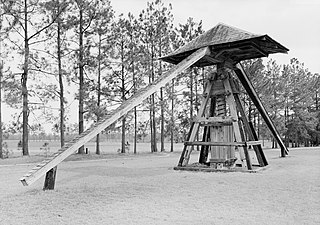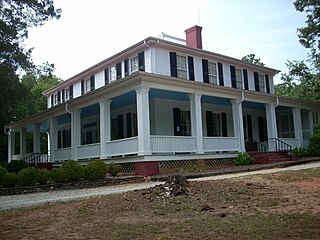
Edgecombe County is a county located in the U.S. state of North Carolina. As of the 2020 census, the population was 48,900. Its county seat is Tarboro.

Tarboro is a town located in Edgecombe County, North Carolina, United States. It is part of the Rocky Mount Metropolitan Statistical Area. As of the 2020 census, the town had a population of 10,721. It is the county seat of Edgecombe County. The town is on the opposite bank of the Tar River from Princeville. It is also part of the Rocky Mount-Wilson-Roanoke Rapids CSA. Tarboro is located near the western edge of North Carolina's coastal plain. It has many historical churches, some dating from as early as 1742.
Oakland Plantation may refer to:

Coolmore Plantation, also known as Coolmore and the Powell House, is a historic plantation house located near Tarboro, Edgecombe County, North Carolina. Built in 1858–61, the main house is one of the finest Italianate style plantation houses in the state. The house and its similarly styled outbuildings were designed by Baltimore architect E. G. Lind for Dr. Joseph J.W. and Martha Powell. Coolmore was designated a National Historic Landmark for its architecture in 1978, and is a Save America's Treasures projects.

Kirkwood is a historic plantation house in Eutaw, Alabama. The house was recorded by the Historic American Buildings Survey in 1934 and by Carol M. Highsmith in 2010. It was placed on the National Register of Historic Places on May 17, 1976, due to its architectural significance.

The Latta Cotton Press is an early mule-powered, wooden cotton press built around 1798. It was built and operated at Berry's Crossroad on South Carolina Highway 38 south of Latta in Dillon County, South Carolina. It was moved about 2.5 mi (4 km) west around 1950. It was listed on the National Register of Historic Places on November 15, 1972.

Ashtabula is a plantation house at 2725 Old Greenville Highway near Pendleton in Anderson County, South Carolina, USA. It has been also known as the Gibbes-Broyles-Latta-Pelzer House or some combination of one or more of these names. It was named in the National Register of Historic Places as a historic district on March 23, 1972. It is considered a significant example of a Lowcountry style plantation house built for a Charleston family in the Upstate in the early 19th century. It also is part of the Pendleton Historic District.

Botany Bay Heritage Preserve & Wildlife Management Area is a state preserve on Edisto Island, South Carolina. Botany Bay Plantation was formed in the 1930s from the merger of the Colonial-era Sea Cloud Plantation and Bleak Hall Plantation. In 1977, it was bequeathed to the state as a wildlife preserve; it was opened to the public in 2008. The preserve includes a number of registered historic sites, including two listed in the National Register of Historic Places: a set of three surviving 1840s outbuildings from Bleak Hall Plantation, and the prehistoric Fig Island shell rings.

The Rocky Mount-Wilson-Roanoke Rapids Combined Statistical Area, as defined by the United States Census Bureau, is an area consisting of five counties in northeastern North Carolina. As of the 2010 census, the CSA had a population of 310,416, with an estimated population of 297,726 in 2018. The statistical area includes the Rocky Mount Metropolitan Statistical Area, Wilson Micropolitan Statistical Area, and Roanoke Rapids Micropolitan Statistical Area, and the counties of Nash, Wilson, Edgecombe, Halifax, Northampton.
Coats House is a historic home located at Tarboro, Edgecombe County, North Carolina. It was built about 1860, and is a two-story, three bays wide, English Cottage style brick dwelling. It features a hipped roof with wide, overhanging eaves and a cupola and four interior end chimneys. Also on the property are the contributing brick kitchen and a frame smokehouse. Its builder, Thomas H. Coats, also built the Calvary Episcopal Church and First Baptist Church in Raleigh, North Carolina.
The Grove, also known as Blount-Bridgers House, is a historic home located at Tarboro, Edgecombe County, North Carolina. It was built about 1808, and is a two-story, five-bay, Federal style frame dwelling. It has a gable roof and pairs of double-shouldered brick end chimneys. It was the home of Thomas Blount (1759–1812), an American Revolutionary War veteran and statesman.
Walston-Bulluck House, also known as the Pender Museum, is a historic home located at Tarboro, Edgecombe County, North Carolina. It was built about 1795, and is a one-story, three-bay, frame dwelling. It has a Hall and parlor plan and two reconstructed double-shouldered brick end chimneys. The house is sheathed in weatherboard, has a gable roof, and rests on a brick pier foundation. It was moved from its original location near Conetoe to its present site in 1969, and restored by the Edgecomb County Historical Society.
Redmond-Shackelford House is a historic home located at Tarboro, Edgecombe County, North Carolina, United States. It was built in 1885, and is a two-story, three bay Second Empire-style stuccoed brick dwelling with a one-story rear wing. It features concave mansard roofs on both sections with round-arched dormers. The interior features an array of painted and plaster ornament. The decoration is attributed to Edward Zoeller, a Bavarian fresco painter, who also decorated the Howell Homeplace. Also on the property is a contributing brick kitchen with a hipped roof.
Oakland Plantation, also known as Lloyd Farm and the Elks Lodge, is a historic plantation house located at Tarboro, Edgecombe County, North Carolina. The frame dwelling dates to the mid-19th century, and consists of a two-story central section with flanking one-story wings and a series of rear additions. It has shallow hip roofs with Italianate brackets and features a one-story porch of the distinctive Tarboro lattice type. By 1931, the dwelling was occupied as an Elks Lodge for the African-American population.
Howell Homeplace, also known as the William Brinkley Howell Homeplace, is a historic home located near Tarboro, Edgecombe County, North Carolina. The frame dwelling dates to the mid-19th century, and is a two-story cubicle house sheathed in weatherboard with a hipped roof. The vernacular Greek Revival interior features extraordinary painted decoration in the entrance and stairhalls. The decoration is attributed to Edward Zoeller, a Bavarian fresco painter, who also decorated the Redmond-Shackelford House. Also on the property is a contributing outbuilding.
Lone Pine is a historic home and national historic district located near Tarboro, Edgecombe County, North Carolina. The district encompasses eight contributing buildings associated with the Lone Pine tobacco farm complex. The house was built about 1860, and is a two-story, rectangular, weatherboarded frame dwelling with Greek Revival and Italianate style design elements. It has a hipped tin roof pierced by two interior chimneys and a hipped tetrastyle portico. Also on the property are several structures and two contributing frame tobacco barns.
Tarboro Historic District is a national historic district located near Tarboro, Edgecombe County, North Carolina. The district encompasses 364 contributing buildings in central Tarboro. It includes a variety of industrial, commercial, residential, and institutional buildings dating from the late-18th through early-20th centuries. Located in the district are the separately listed Tarboro Town Common, The Barracks, Redmond-Shackelford House, Pender Museum, Blount-Bridgers House, Coates-Walston House, Calvary Episcopal Church and Churchyard, and the Cotton Press complex. Other notable buildings include the Morris-Powell House, Porter House, U. S. Post Office (1914), Pippen House (1870s), Dancy-Battle-Bass Clark House, Holderness House, Howard Memorial Presbyterian Church (1908-1909), W. H. MacNair House (1913), Henry Cherry-George White House, Jones House (1870-1875), Tarboro Primitive Baptist Church, St. James Methodist Church (1916), Carolina Telephone & Telegraph (1912), Clark's Warehouse #1 and #2, Battle-Porter-Powell House, Gaskil1-Hussey House (1882), Cheshire-Nash House, and Norfleet Court (1858).
Tarboro Town Common is a historic town common located at Tarboro, Edgecombe County, North Carolina. The common was established in 1760, and is an open space containing several memorials and a fountain. It originally consisted of 50 acres (20 ha). The commons contains five contributing objects: the Cotton Press; a Confederate memorial (1904); an obelisk; a memorial to the Spanish–American War dead; and a two-tier, cast iron fountain.
The Barracks is a historic plantation house located at Tarboro, Edgecombe County, North Carolina. It was built about 1858, and is a two-story, brick dwelling with Greek Revival and Italianate style design elements. It features a central projecting bay with distyle pedimented portico. The portico has fluted columns and a frieze. The house is topped by a cross-gable roof and cupola.
Farrar is an unincorporated community in Edgecombe County, North Carolina, United States. The town was probably named for Owen Cicero Farrar, a leading member of the local Baptist church and businessman who ran the general store, the Hotel Farrar, and founder of the Tarboro Cotton Factory constructed in 1888 in nearby Tarboro.












